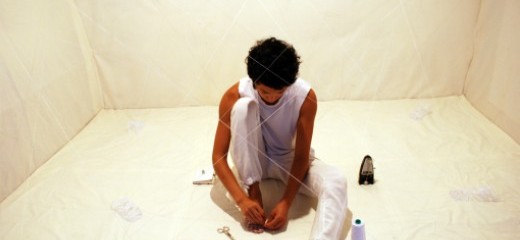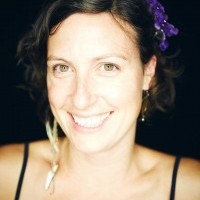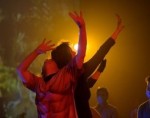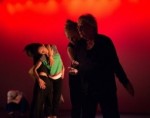
Photo: William Bilwa Costa
Leaving Stable Grounds
by Megan Bridge
In early August, the
is.m festival (improvised sound and movement) brought together experimental artists from many geographical and disciplinary backgrounds in Vienna, one of my favorite cities on the planet (after Philadelphia). When I heard about this festival, organized by a good friend and during a time when I would already be in Europe, I knew I couldn’t miss it. I convinced my partner and collaborator to postpone a research fellowship in the Swiss Alps for a few days, reconnected with some very good friends in Vienna who were willing to host us, packed up my family, and descended on this beautiful city in the heat of summer.
On August 1 we stumbled off the U-Bahn into Vienna’s 11th district. With our two-year-old daughter strapped to my back, I led the way through streets that were immediately familiar after our 3-year absence. (We spent a lot of time in Vienna from 2009-2010 when I was working with Austrian choreographer Willi Dorner). My husband brought up the rear, negotiating luggage with our five-year-old in tow, pointing out familiar details and reminding our son that we called this neighborhood home for almost two months when he was a toddler. Vienna has always reminded me of Philadelphia because of its size (in population and geographical spread) and similar accessibility (it’s pretty easy to find one’s way around there and here, although SEPTA can’t hold a candle to Vienna’s public transport). Both cities have the resources to support some major players in the arts, boasting world class orchestras and international performance festivals. But their dance and performance scenes are lively, flexible, and navigable enough so that new arrivals and emerging artists can still make an impact.
Vienna...summer....dance...to the initiated, what probably springs to mind is
ImPulsTanz: Vienna International Dance Festival. Self-proclaimed as “
Europe’s biggest contemporary [dance] festival,”
ImPulsTanz’s bountiful offering of workshops and performances draws dance aficionados from all over the world.
is.m was produced on a much smaller scale, spanning seven days, with seventy total participants who took part in three workshops and seventeen different performances. My company
performed, taught, and shared research with fellow artists and festivalgoers. Our trip was so short (four days) and our schedule so packed that I hardly noticed ImPulsTanz (the elephant in the room). Most others not only noticed but very much appreciated the simultaneity of the two festivals. According to performance artist Jasmin Schaitl, whose solo Arranging Pace was part of is.m: “The big plus point of is.m was that it was happening at the same time as ImPulsTanz in Vienna, which meant that a lot of international people were present for the is.m festival. It was a very nice and open atmosphere, and the audiences and the performers found their way of connecting and networking.”
i s.m was conceived by Philadelphia ex-pat, William “Bilwa” Costa, who left town in 2009 and has since been traveling the world (spending significant chunks of time in Mexico City, Berlin, London, and Helsinki), making art, performing in festivals, and now organizing them. Co-curator Max Bogner, aka “Margaret Unknown,” is an organizer at mo.ë, an experimental performance/work space housed in an old Vienna factory building (or “fabrik”). To say that mo.ë, the site of all is.m festival activities, is rough-and-tumble would be an understatement. The cavernous warehouse has concrete floors and crumbling walls, and some lighting fixtures that dangle a bit dangerously. For is.m, the performance area was designated by an area of taped-down cardboard, swept clean periodically and treated like any other dance floor (no shoes, please. Also, by the way, bare feet or other expanses of bare skin make a lovely sound when sliding over cardboard. Great for improvising sound and movement artists). But the energy and generosity of the personnel at mo.ë make up for what it lacks in appointments. Again, according to Jasmin: “‘The mo.ë space in Vienna is of course a great space for festivals like that. With some funding, it could go much further.”
Funding is always a major theme of conversation in the arts. And at this festival it was no exception. One of the most exciting things about is.m, for me, was to see the mobilization of very limited resources around a common goal. People want to make art. People want to share it with each other. According to festival organizer Bilwa: “Max and I decided to organize a festival dealing with movement and sound in the context of improvisation. We applied for funding, but we didn't receive any. We stopped discussing the idea for a while, but then we decided to make the festival anyway, without funding...you can be self-motivated, and make some things happen, or you can wait for the funding to make things happen.”
As for the curatorial vision behind
is.m, the organizers were interested in the many different ways one can look at improvisation. Included in the festival’s offerings were a “nine-hour physical improvised action with a definite structure,” an interdisciplinary group action whose structure and some content were determined by tarot cards, a performance featuring
sine waves and head movements, and apparently “only one official dancer,” according to Bilwa. In his words, my company’s performance was “a very pure and proper, site specific improv of sound/movement.”
Artists from all different disciplines gathered at is.m, many from visual arts backgrounds who are working with sound and movement as material in works that are more conceptual or imagistic. For one such artist, Vienna-based Christian Schroeder,
“[t]he interactions and the influences that happen during improvisation, as well as the practice of improvisation open a lot of questions for me and that is what I like about it. Rather than forcing virtuosity it helps with focusing and concentrating, to act and react, and encourages me to leave stable grounds and try something else.”
Leaving stable grounds and trying something else. This statement sums up my experience at is.m, and in many ways my whole summer. The energy at is.m and at mo.ë supported an “anything goes” atmosphere. And there was a lot that went. On the other hand, my peers and colleagues at the festival were deeply invested in their own processes of experimentation and research, and a certain level of rigor accompanied each artist’s approach. One of the large group ensembles, Objects Are Also Human, moved through the whole space and interacted so freely with the audience that some latecomers, unsure who were the performers and who weren’t, joined in, theatrically smoking a cigarette while gazing intently at each other. The group leaders communicated constantly, speaking directions to each other or posing existential questions into a microphone. A small cluster of performers and audience members huddled on the floor, learning how to read tarot cards, while other performers wandered through the space balancing on chairs, stuffing pillows in shirts, imploring spectators to pose, stretch, or shift their viewing positions.
Limit State, a performance outgrowth of a workshop led by Aiko Kazuko Kurosaki, had more defined structure. Another large ensemble, the performers started installation-style, spread all over the space performing mostly solo, task-based movement investigations. The group gradually gathered on stage and performed a slowly unfolding and clearly structured group improvisation. When my attention flagged, I was buoyed by Pia Palme’s alternately sweeping and incisive sonic contributions on her contrabass recorder and electronics.
In fidget's thirty-minute improvised set, I danced solo, with nothing else on stage. I was able to fully open my attention to the environment: my collaborator, Peter Price’s music, the dangling light fixtures, the crumbling walls, my own shadow...all of these details poured into my consciousness and alternately propelled my body through space or compelled me to stop, be still, and listen. I was intensely aware of my audience. Seeing them see me often made me smile, which sometimes made them smile back.
There was a tension at is.m, many performances danced the fine line between controlled chaos and a hot mess, between minimalism and tedium, and between deep personal investigation and naval gazing. This summer, in the shadow of better-funded festivals and venues, is.m drew a group of practitioners that demonstrated an unwavering commitment to their craft. Now autumn is upon us. But stay tuned...according to Bilwa, there are plans for is.m’s future, “next year, three days in Vienna and three days in Berlin.”
is.m, improvised sound.movement. August 1-7, 2013. mo.ë, Vienna.
All photos associated with this article: (c) copyright Jasmin Schaitl.
By Megan Bridge
September 15, 2013










